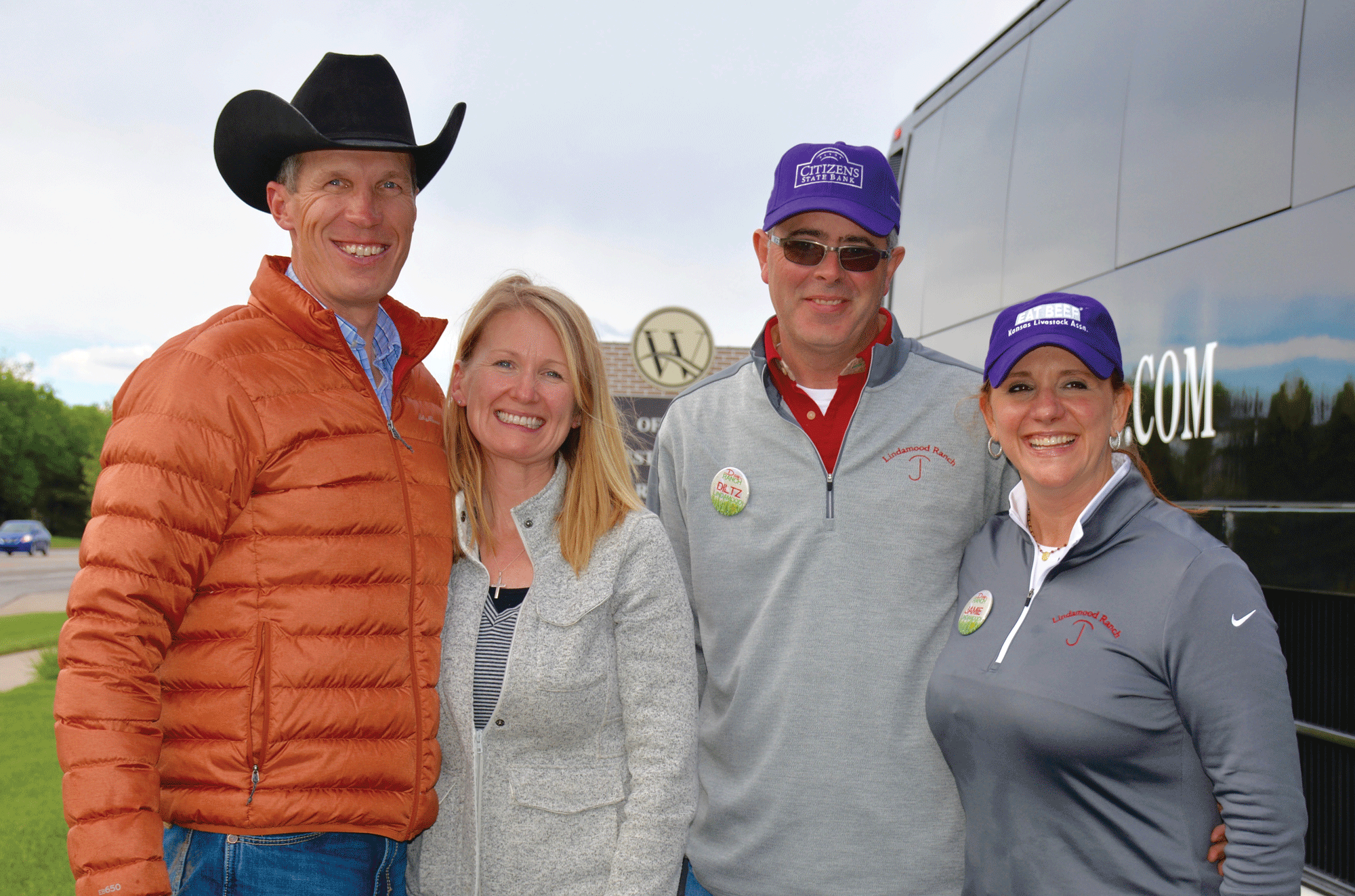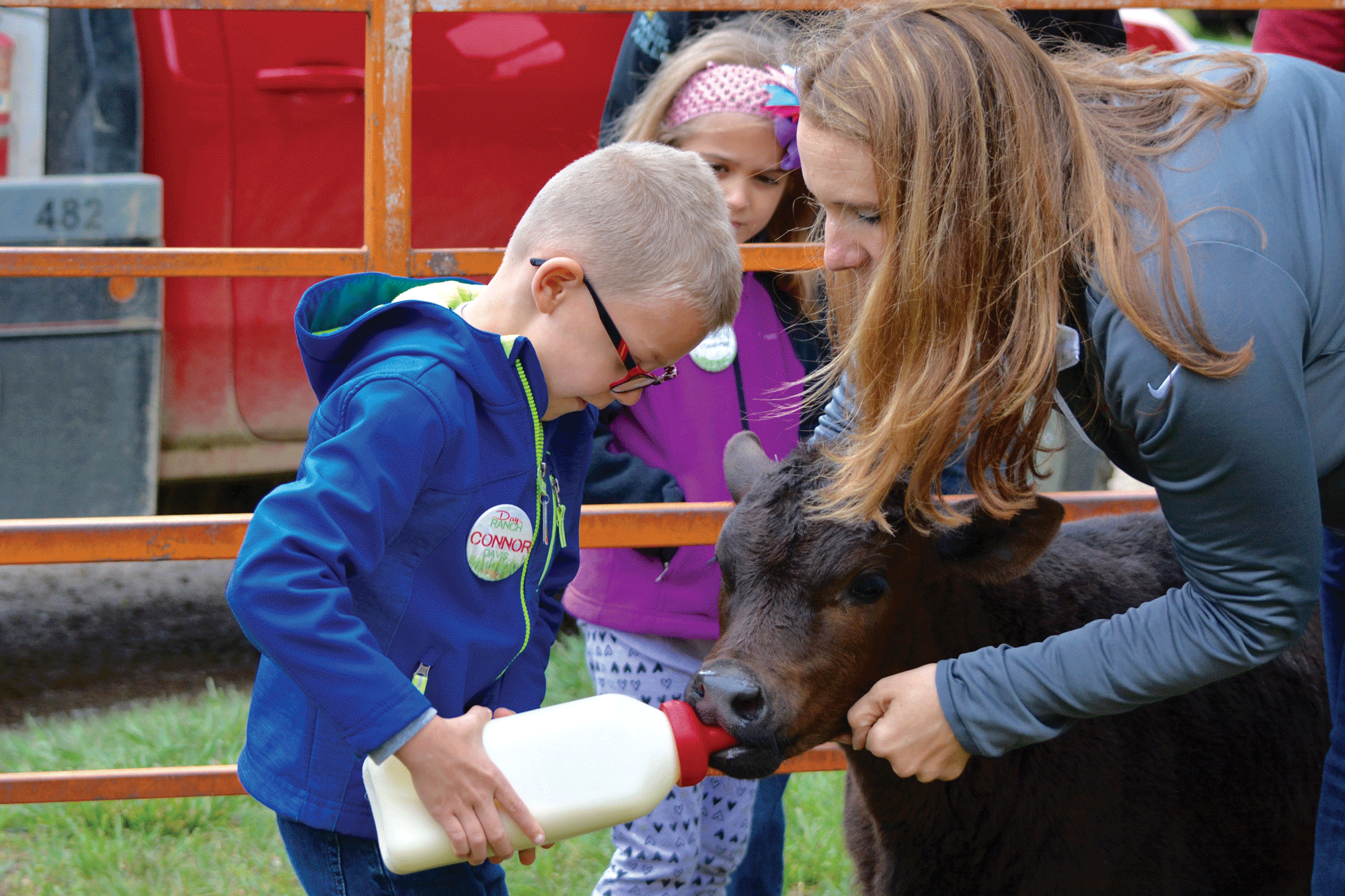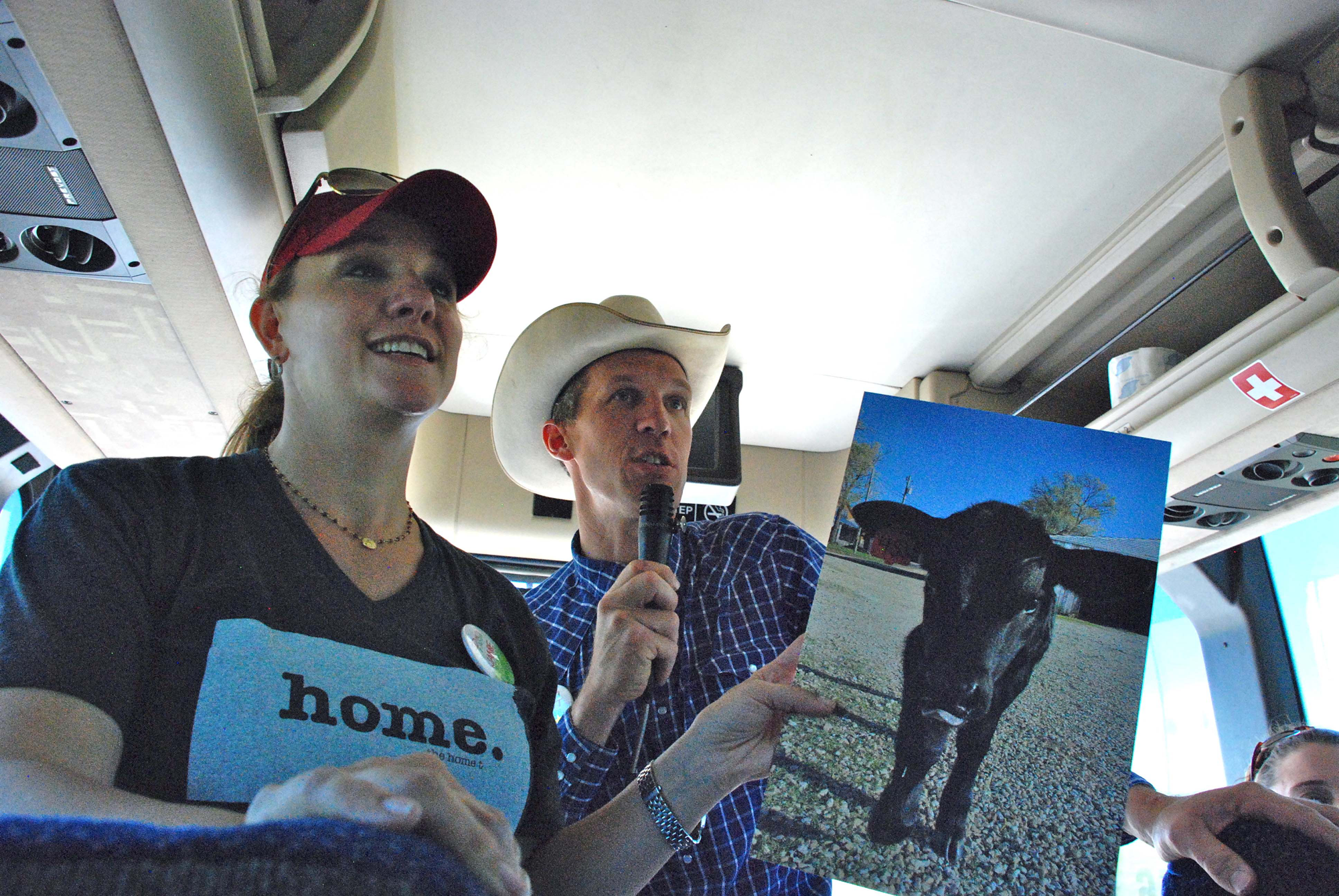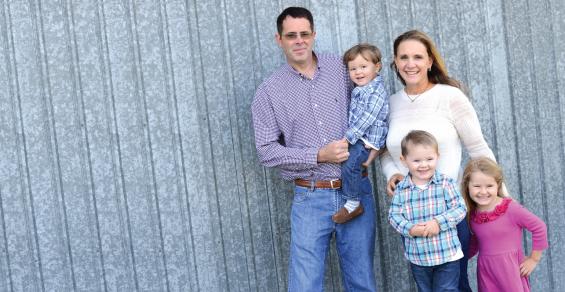If it takes a village to raise a child, how many people does it take to help consumers better understand how and why you do what you do to provide them with safe, wholesome beef?
Just one spark plug.
Meet Jamie Lindamood, BEEF magazine’s 2017 Trailblazer Award winner. Friends say she’s a bundle of energy who doesn’t take no for an answer, thinks big and has the persistence to see her vision to fruition.
She’s the spark plug behind A Day at the Ranch, a day-long opportunity for consumers in suburban and urban Wichita, Kan., to meet the people who raise the beef they eat, and learn what those people do every day to make sure their cattle are healthy and well cared for.
With two tours behind them, Jamie and her husband, Diltz, along with Matt and Amy Perrier with Dalebanks Angus, have trained an army of beef advocates who are educated and willing to tell the beef story to their friends and neighbors in Wichita. The Lindamood and Dalebanks ranches are near Eureka, in the Kansas Flint Hills, about an hour-and-a-half east of Wichita.
“The tour is bringing people from Wichita out to the beautiful Flint Hills to learn about production agriculture,” Jamie says. It’s a busload of people, with a caravan of cars following behind. The bus is dedicated to adults only. That’s so they are able to stay engaged in the conversation on the trip out and the trip back. Those who want to bring their kids follow in their cars.
The first stop is the Lindamood Ranch, where the group is introduced to farming and ranching. “We talk farming, equipment, technology and turning seed into food — the food they eat,” she says. “And we talk about how we feed the cattle as well. And talk about the native grass in the Flint Hills, which is really special to our part of the world.”
That’s important because of the annual pasture burning that Flint Hills ranchers do. It’s a vital part of the Flint Hills ecosystem, keeping the pastures healthy and growing. But it produces a lot of smoke, much of which heads straight for Wichita. Once folks understand why ranchers burn their pastures every year and how vital it is to keeping the land healthy, the ranchers have advocates who can explain that to their neighbors when the skies over Wichita get hazy.
Then they head to Dalebanks Angus and talk about how ranchers care for their cattle. “We actually work some cows, work some calves, and talk about vaccinations, added hormones and why we make the choices we do.”
And it’s been successful. More on that later.
How it came about
Jamie is not your traditional farm and ranch wife. She grew up in Wichita, a city girl, and didn’t become a country girl until she married Diltz almost nine years ago. That’s not to say, however, that she didn’t grow up with an appreciation for agriculture. Her grandparents had a farm, and when Jamie’s family would visit on the weekends, she got that rural exposure.
That left an impression. “I actually am the person that most farmers and ranchers think of when they think of city folk,” she says. “Unfortunately, too many generations have passed at this point, with only 2% to 3% of the population farming and ranching; and there are too many people who just have no connection, no lifeline, to agriculture at all,” she says.
Yet, with the cultural trend toward knowing more about how food is grown and where it comes from, there’s a wide gap between the farm and the fork. “And truly unfortunately, we have had consumers say they never would think to reach out to a farmer or rancher to ask the questions they have about how their food is grown.” Instead, they turn to the internet, and they’re trusting marketing professionals and anti-agriculture voices to teach them about how their food is grown.
“So two years ago in January, my husband, Diltz, and I went to the Kansas Livestock Association Leadership Conference in Topeka. At that time, Matt Perrier was president of KLA, so he was up there for the conference as well.
“Over the years, it had become clear that I needed to bring friends out to the ranch to show them what agriculture really looks like. But even bringing a few people out took a whole day, so I thought a big group would be less time-consuming — but knew I couldn’t do it myself.”

The fearless foursome of Matt (from left) and Amy Perrier, and Diltz and Jamie Lindamood teamed up to bring consumers from Wichita, Kan., to the Kansas Flint Hills for a firsthand experience with where their food comes from.
So, at dinner one night while they were at the conference, she asked Matt if he would be willing to do a ranch tour with her. “And he said, ‘Absolutely.’ Matt is so incredibly well-spoken about all things agriculture, and he is the perfect person to partner with. So, with the help of the Perriers, A Day at the Ranch was born.”
They decided to hold the tour in April. “That’s the busiest time on the ranch here in the Flint Hills. That’s when we are burning, have just finished calving, and we’re getting ready to start planting. So many things all happening at the same time makes it even more exciting to outsiders, and the perfect time to tell agriculture’s story.”
Jamie was involved in several active groups in Wichita before moving to the Lindamood Ranch, and remains involved. That created the perfect opportunity to invite people on the tour. One group is the Junior League of Wichita.
“It’s an organization of about 800 women, and our target market to educate. They’re the grocery shoppers, the meal preparers, they’re the people who are going to decide what their families eat,” she says. She’s also involved in Rotary, and several members of the club joined the tour as well.
“The first year of the tour, I knew almost everyone, but Matt knew very few. In that hour and a half [bus ride out to the ranch], it’s amazing how much of a bond you can build with someone. That was our goal, to earn their trust on the way, so they would open up and ask us questions, without feeling judged or that their questions were stupid,” Jamie says.
The 2017 tour was equally as successful. Some of the participants went on the first tour and wanted to learn more; some heard about it from friends who went the year before. But this time, there were a lot more people who didn’t know Jamie and Matt at all.
“For the second tour, I did some radio and I did news spots on all three of the Wichita television stations. We had some consumers who came on the tour because they saw me on the news, and they thought it sounded like fun,” she says.
“The timing was pretty perfect, too. With May being Beef Month, several stations asked me to come back after the tour to get a breakdown of how the tour went, but also to talk beef. A lot of residents have no idea that Kansas is such a big player in the beef community, and how important beef is to Kansas and our economy. One of the statistics consumers and interviewers find interesting is that cattle outnumber people 2-to-1 in the state of Kansas. That gets everyone excited.”
Has it worked?
“It really is exciting to see that we actually are making friends for agriculture through the tour. And it’s important to get the word out,” she says. “Consumers are genuinely interested in seeing how their food is grown and where it comes from.”
Consumers weren’t the only ones to learn during the tours. The ranchers learned something, too — the miscommunication and disconnect from one another. “The consumer wants to know where their food comes from, and they don’t know where to look. One gal actually said, ‘I spend a lot of time researching about my food online, and I just Google questions. It never crossed my mind to ask a farmer.”

It’s a good bet that this young man will remember bottle-feeding a calf for a very long time. And the positive experiences he had while attending A Day at the Ranch are likely to stay with him and be a buffer to the many negative messages he will hear about the beef business.
But when consumers use the internet, they find answers that someone else wants them to find. “Sadly, bad information is more readily accessible than the truth about agriculture. I think that is one of the most important reasons we do this, to share and show and build those relationships. We want them to call us when they have a question about something they saw online or in the grocery store, or that was confusing to them. We have to get good information out there.”
One way that happens is through social media. “We have Instagram and a Facebook page that she [Jamie] posts on almost every day for Greenwood County CattleWomen,” says Amy Perrier, Matt’s wife. “She’s getting the word out every day with that page and continues to be very passionate about it.”
The page now has 790 followers. “It’s not viral by any means, but I would say it’s probably closer to 20 to 30 followers before she [Jamie] broadened the scope,” Matt says. “And that’s what she’s done in a lot of ways. Instead of just talking to ourselves, she wants us to talk to those who really want and need to hear our story.”
What they learned
Conducting the two tours was every bit as educational for the ranchers as it was for the consumers. But make no mistake, the consumers who have gone on the tour came away with a new and refreshing outlook.
“On both tours, on the way home, we had people ask how they could advocate on our behalf. How can they repeat, how can they help tell agriculture’s story?”
And the ranchers learned a lot, too. “”The first tour was really eye-opening for us,” Amy says. “We were really worried going into it what the reaction would be. But there weren’t a lot of anti-ag views. It was just not knowing and not understanding.”
“The thing I have gained from it that I didn’t realize is how our consumers and friends in suburban and urban America look at food as more than just sustenance; it’s more of an actual experience and a story,” Matt says.
“And also how much they crave hearing from us. That part I didn’t realize,” he says. “We were prepared to defend beef and our production methods. And, while they had some questions about antibiotics, hormones and implants, the thing they were just so interested in was the passion we have, and every ranch family has, for the product that we raise and for the multigenerational ownership of these family businesses. They didn’t realize that even existed.”
In fact, Matt says tourgoers asked him if he realized that very few people in America know that anybody still has this kind of passion and has this kind of family involvement in their business. “That was really eye-opening to me. We not only taught these people about what we do, but we ourselves learned just how special and unique of a job — a career — we have.”

On the bus ride from Wichita to the Kansas Flint Hills and the Lindamood Ranch and Dalebanks Angus gave Jamie Lindamood and Matt Perrier plenty of time for a little Ranching 101, to explain some of the terms that are familiar to ranchers but foreign to consumers.
“We had a lot of good takeaways from it,” Jamie says. “We learned that, fortunately or unfortunately, depending on you look at it, talking and teaching about agriculture is just as important as growing it in so many ways these days.”
According to Jamie, another important takeaway for the ranchers is that the two groups just don’t speak the same language. “We’re speaking over their heads a lot of times when we’re trying to explain things. They get lost when we use common industry terms they don’t understand.”
And important points get lost, because the tourgoers disconnected a long time before the ranchers got to the point of the story, she says. “We had to take a step back more than once and set some groundwork. For example, animal husbandry. We are talking steers and heifers, and they got lost. To them, all cattle are cows. To us, a bull is not a cow. So we paused and had a lesson, with photos, of cattle 101.”
Important advice
Given the revelation that what is second nature to a rancher is brand-new to a consumer, Jamie says anyone who wants to do a similar tour is well advised to have an “interpreter” and a well-spoken rancher. “You need someone who relates to and understands both sides, someone who can interject and help explain, so everyone is on the same page.” On their tours, Matt was the well-spoken rancher and Jamie was the interpreter.
Beyond that, she says being honest is vital. “You’re not supposed to be showing only the pretty side of agriculture and leaving out the things that we do that are controversial, like antibiotics or hormones, technology or pesticides,” she says. “Bring it to the front, talk about it and explain why and how we do things. If not, it looks like we’re trying to hide something that we shouldn’t be trying to hide.”
Beyond that, she says it‘s helpful to include other experts to talk with the group. They had a veterinarian, a beef cattle nutritionist and the USDA conservationist on hand. “We really wanted them to see it is a family that is raising these animals. And it’s also a business.”
And she advises that everyone involved in communicating with consumers get Beef Quality Assurance (BQA)-certified and take the Masters of Beef Advocacy training. That knowledge is very helpful in telling beef’s story to consumers.
“We found that the best advocate we have in agriculture is the consumer. So teaching one consumer so that they can teach five more, and so on, is our best avenue to educate the country and make them understand how agriculture actually works,” Jamie says.




Leave A Comment